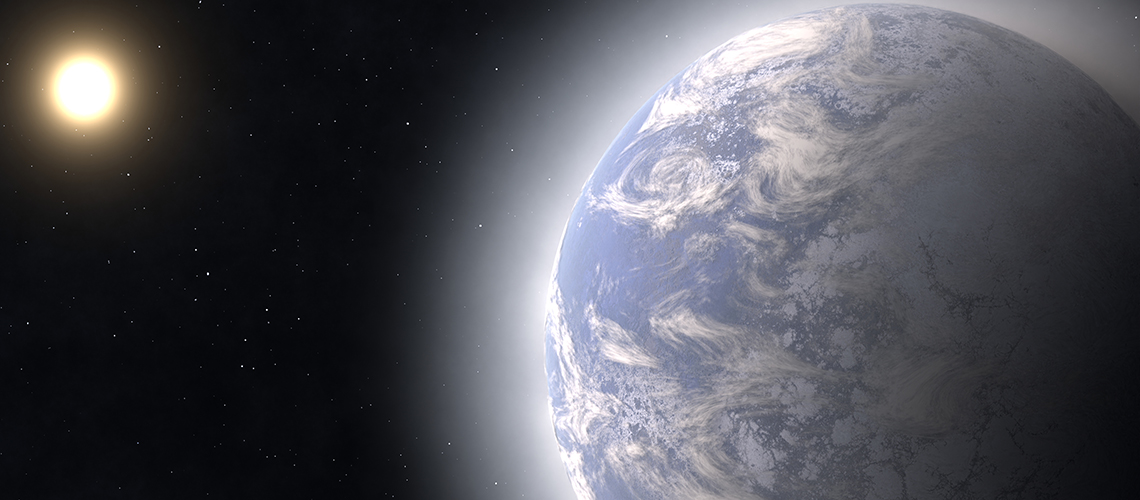Follow us on Google News (click on ☆)

As icy, water-rich ocean planets migrate toward their star, the ice melts and eventually forms a thick water vapor atmosphere, which increases their radius.
© Thomas Müller / MPIA
As these planets move closer to their central star, the evaporating water ice forms an atmosphere that makes them appear larger than in their frozen state, well beyond an Earth-radius doubling. Simultaneously, smaller rocky planets, larger than Earth, gradually lose part of their original gaseous envelope, leading to a significant radius reduction. These findings open new perspectives for the study of exoplanets. They are featured in Nature Astronomy.
In 2017, the Kepler space telescope revealed the absence of planets sized about two Earth radii. This gap in the planet radius distribution is called the "sub-Neptunian rift." "Its existence is one of the most significant observational constraints for understanding the origin and composition of exoplanets with radii between that of Earth and Neptune," explains Julia Venturini, Ambizione Fellow at the SNSF, a scientific collaborator at UNIGE's Department of Astronomy, member of the NCCR PlanetS, and co-author of the study. "Like other research groups, we had predicted based on our calculations, even before the 2017 observations, that such a rift should exist," adds Christoph Mordasini, professor at UNIBE's Space Research and Planetary Sciences (WP) division, member of the NCCR PlanetS, and co-author of the study.
Where Does the Sub-Neptunian Rift Come From?
Two types of exoplanets populate the radius interval between one and four Earth radii. On one hand, rocky planets - "super-Earths" - larger than Earth. On the other, gaseous planets called sub-Neptunian planets (or mini-Neptunes), some of which, the ocean planets, might host enough water to be covered in an icy ocean several tens of miles deep. Among these two types of planets, super-Earths and sub-Neptunians, astronomers find very few with a radius twice that of Earth.
To explain the emergence of this "rift," the most commonly suggested mechanism is that planets lose part of their original atmosphere due to stellar irradiation. "This explanation assumes that planets form and remain very close to their star, where they would be dry, without water," specifies Julia Venturini. "However, this explanation contradicts formation models, which show that planets sized between two and four Earth radii, the ocean planets, generally come from the coldest, most distant regions of the stellar system."
Numerous clues suggest that some planets might move away from their birthplace during their evolution, migrating inward or outward in their system. This migration would allow planets born in cold, icy regions, like ocean planets, to complete their formation on orbits very close to their star.
Wandering Ocean Planets
As icy, water-rich ocean planets migrate toward their star, the ice melts and eventually forms a thick water vapor atmosphere. This process leads to an increase in their radius to slightly higher values, beyond a double Earth radius. Conversely, water-poor super-Earths "shrink" by losing the volatile gases from their original atmosphere, such as hydrogen and helium, under the influence of the star.
Combined computer models of formation and evolution thus indicate that the migration of ocean planets significantly contributes to the large number of planets detected with a radius greater than two Earth radii, while the atmospheric evaporation of super-Earths contributes to the overabundance of planets smaller than two Earth radii. At the center of these two populations lies the sub-Neptunian rift. "We already obtained this result in 2020. The new study confirms it with a different formation model. This strengthens the conclusion that sub-Neptunian planets are primarily worlds of water," states Julia Venturini, who also led the 2020 study.
Further Work to Come
In addition to explaining a hitherto mysterious phenomenon, these findings open new avenues for the study of exoplanets. "If we extend our results to more temperate regions, where water is liquid, this could suggest the existence of aquatic worlds with deep liquid oceans," explains Christoph Mordasini. "Such planets could potentially harbor life and would be relatively straightforward targets for the search for biomarkers due to their size."
Observations with telescopes like the James Webb Space Telescope or the Extremely Large Telescope, currently under construction, could also prove helpful. They would allow determining the atmospheric compositions of planets based on their size, which would test the described simulations.